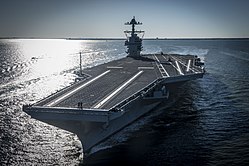| Class | Operators | Displacement | Ships in class | Type | Year of first Commission |
|---|
Kuznetsov-class  |  Russian Navy, Russian Navy,  People's Liberation Army Navy People's Liberation Army Navy | 57,700 tons | 3 | Aircraft Carrier (Heavy aircraft-carrying Cruiser) | 1995 |
Cavour-class  |  Italian Navy Italian Navy | 27,190 tons | 1 | Aircraft Carrier | 2008 |
Chakri Naruebet-class  |  Royal Thai Navy Royal Thai Navy | 11,486 tons | 1 | Light Aircraft Carrier | 1997 |
Charles de Gaulle-class  |  French Navy French Navy | 40,500 tons | 1 | Aircraft Carrier | 2001 |
Gerald R. Ford-class  |  United States Navy United States Navy | 100,000 tons | 1 (+2) | Aircraft Carrier | 2017 |
Vikrant-class  |  Indian Navy Indian Navy | 45,000 tons | 1 | Aircraft Carrier | 2022 |
Vikramaditya-class  |  Indian Navy Indian Navy | 45,400 tons | 1 | Aircraft Carrier | 2022 |
Nimitz-class  |  United States Navy United States Navy | 97,000 tons | 10 | Aircraft Carrier | 1975 |
Queen Elizabeth-class  |  Royal Navy Royal Navy | 70,600 tons | 2 | Aircraft Carrier | 2017 |
Kirov-class  |  Russian Navy Russian Navy | 25,860 tons | 4 (-2) | Battlecruiser | 1980 |
Slava-class  |  Russian Navy Russian Navy | 11,490 tons | 2 | Cruiser | 1982 |
Ticonderoga-class  |  United States Navy United States Navy | 9,800 tons | 17 | Cruiser | 1982 |
Type-051B (Luhai-class)  |  People's Liberation Army Navy People's Liberation Army Navy | 6,100 tons | 1 | Destroyer | 1999 |
Type-051C (Luzhou-class)  |  People's Liberation Army Navy People's Liberation Army Navy | 7,100 tons | 2 | Destroyer | 2006 |
Type-052 (Luhu-class)  |  People's Liberation Army Navy People's Liberation Army Navy | 4,800 tons | 2 | Destroyer | 1993 |
Type-052B (Luyang I-class)  |  People's Liberation Army Navy People's Liberation Army Navy | 6,200 tons | 2 | Destroyer | 2004 |
Type-052C (Luyang II-class)  |  People's Liberation Army Navy People's Liberation Army Navy | 7,000 tons | 6 | Destroyer | 2004 |
Type-052D (Luyang III-class)  |  People's Liberation Army Navy People's Liberation Army Navy | 7,500 tons | 20 (+5) | Destroyer | 2014 |
Type-055 (Renhai-class)  |  People's Liberation Army Navy People's Liberation Army Navy | 12,000 to 13,000 tons | 8 (+4) | Large Destroyer | 2020 |
Akizuki-class  |  Japan Maritime Self-Defense Force Japan Maritime Self-Defense Force | 6,800 tons | 4 | Destroyer | 2012 |
Almirante Brown-class  |  Argentine Navy Argentine Navy | 3,360 tons | 3 | Destroyer | 1983 |
Arleigh Burke-class  |  United States Navy United States Navy | 8,315 to 9,700 tons | 70 | Destroyer | 1991 |
Asagiri-class  |  Japan Maritime Self-Defense Force Japan Maritime Self-Defense Force | 5,200 tons | 8 | Destroyer | 1988 |
Atago-class  |  Japan Maritime Self-Defense Force Japan Maritime Self-Defense Force | 10,000 tons | 2 | Large Destroyer | 2007 |
Chungmugong Yi Sun-sin-class  |  Republic of Korea Navy Republic of Korea Navy | 6,250 tons | 6 | Destroyer | 2003 |
Delhi-class  |  Indian Navy Indian Navy | 6,200 tons | 3 | Destroyer | 1997 |
Durand de la Penne-class  |  Italian Navy Italian Navy | 5,560 tons | 2 | Destroyer | 1993 |
Gwanggaeto the Great-class  |  Republic of Korea Navy Republic of Korea Navy | 3,900 tons | 3 | Destroyer | 1988 |
Hatakaze-class  |  Japan Maritime Self-Defense Force Japan Maritime Self-Defense Force | 6,096 tons (Hatakaze) 6,147 tons (Shimakaze) | 2 | Destroyer | 1986 |
Hatsuyuki-class  |  Japan Maritime Self-Defense Force Japan Maritime Self-Defense Force | 4,000 tons | 12 | Destroyer | 1982 |
Hobart-class  |  Royal Australian Navy Royal Australian Navy | 7,000 tons | 3 | Destroyer | 2017 |
Horizon-class  |  French Navy, French Navy,  Italian Navy Italian Navy | 7,050 tons | 4 | Destroyer | 2007 |
Kashin-class  |  Russian Navy, Russian Navy,  Indian Navy Indian Navy | 4,390 tons | 2 | Destroyer | 2007 |
Kee Lung (Kidd)-class  |  Republic of China Navy Republic of China Navy | 9,783 tons | 4 | Destroyer | 1981 |
Kolkata-class  |  Indian Navy Indian Navy | 7,400 tons | 3 | Destroyer | 2014 |
Kongō-class  |  Japan Maritime Self-Defense Force Japan Maritime Self-Defense Force | 9,485 tons | 4 | Large Destroyer | 1993 |
Maya-class  |  Japan Maritime Self-Defense Force Japan Maritime Self-Defense Force | 10,250 tons | 2 | Large Destroyer | 2020 |
Murasame-class  |  Japan Maritime Self-Defense Force Japan Maritime Self-Defense Force | 6,200 tons | 9 | Destroyer | 1996 |
Sejong the Great-class  |  Republic of Korea Navy Republic of Korea Navy | 8,200 tons | 3 | Destroyer | 2007 |
Sovremenny-class  |  Russian Navy, Russian Navy,  People's Liberation Army Navy People's Liberation Army Navy | 8,480 tons | 6 (-2) | Destroyer | 1980 |
Takanami-class  |  Japan Maritime Self-Defense Force Japan Maritime Self-Defense Force | 6,500 tons | 5 | Destroyer | 2003 |
Type 42 (Sheffield-class)  |  Royal Navy Royal Navy | 4,350 to 5,350 tons | 1 | Destroyer | 1975 |
Type 45 (Daring-class)  |  Royal Navy Royal Navy | 8,500 tons | 6 | Destroyer | 2009 |
Udaloy-class  |  Russian Navy Russian Navy | 7,620 tons | 6 | Destroyer | 1980 |
Visakhapatnam-class  |  Indian Navy Indian Navy | 7,400 tons | 2 (+2) | Destroyer | 2021 |
Zumwalt-class  |  United States Navy United States Navy | 15,907 tons | 2 (+1) | Destroyer | 2016 |
Izumo-class  |  Japan Maritime Self-Defense Force Japan Maritime Self-Defense Force | 26,000 tons | 2 | Light Carrier (Helicopter Destroyer) | 2015 |
Hyūga-class  |  Japan Maritime Self-Defense Force Japan Maritime Self-Defense Force | 19,000 tons | 2 | Helicopter Carrier (Helicopter Destroyer) | 2015 |








































































































